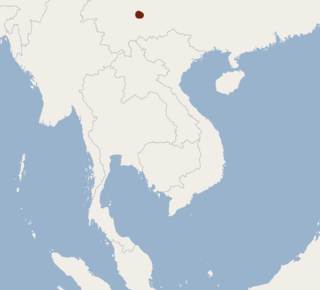
The serotine bat, also known as the common serotine bat, big brown bat, or silky bat, is a fairly large Eurasian bat with quite large ears. It has a wingspan of around 37 cm (15 in) and often hunts in woodland. It sometimes roosts in buildings, hanging upside down, in small groups or individually. The name serotine is derived from the Latin serotinus which means "evening", while the generic name derives from the Greek ἔπιεν and οίκος which means "house flyer".

The genus Plecotus consists of the long-eared bats. Many species in the genus have only been described and recognized in recent years.

The Alpine long-eared bat or mountain long-eared bat is a species of long-eared bat. It was originally described from Switzerland and Austria as a species intermediate between the brown long-eared bat and the grey long-eared bat in 1965. It was later described in 2002, from France and Austria, respectively. Despite its name, this species is not restricted to the Alps, being found in Croatia, Bosnia and Herzegovina and elsewhere. It differs from other European long-eared bats, such as the brown long-eared bat, by its white underparts.

The desert long-eared bat is a species of vesper bat found in North Africa and the Middle East.
Christie's big-eared bat, also known as the Egyptian long-eared bat or gray long-eared bat, is a species of vesper bat in the family Vespertilionidae. It is endemic to Egypt. Its natural habitats are subtropical or tropical dry shrubland, rocky areas, and hot deserts.

The Canary big-eared bat, also known as the Tenerife long-eared bat is a species of vesper bat endemic to the Canary Islands. According to the IUCN, it is vulnerable to the risk of extinction. The species is primarily found in woodland habitat at elevations between 100 and 2300 m. It feeds mainly on moths. Roosting sites include caves, lava tubes and abandoned buildings.

The eastern long-eared bat, species Nyctophilus bifax, is a small flying mammal, a vespertilionid bat. It is found in eastern Australia and Papua New Guinea.

The small-toothed long-eared bat, species Nyctophilus microdon, is a vespertilionid bat. This flying mammal is found only in Papua New Guinea.
Scott's mouse-eared bat is a species of vesper bat. It is found only in Ethiopia, in subtropical or tropical moist montane forests and shrubland. It is threatened by habitat loss.

Grandidier's trident bat is a species of bat in the family Hipposideridae endemic to Madagascar. It was formerly assigned to the genus Triaenops, but is now placed in the separate genus Paratriaenops.

The Vespertilioninae are a subfamily of vesper bats from the family Vespertilionidae.
The Japanese long-eared bat is a species of vesper bat endemic to Japan, where it is found in Hokkaido, Honshu and Shikoku. It has distinctive, long ears, hence its Japanese name, the 'rabbit bat'. Formerly included as a subspecies of the European bat Plecotus auritus, genetic studies now indicate Plecotus sacrimontis is a separate species.

Kolombatovic's long-eared bat, also known as the Mediterranean long-eared bat, is a European species of bat found in the Balkans.
The Turkestani long-eared bat, Otonycteris leucophaea, is a species of bat found in Asia. Though it was initially described in 1873 as a species, for many years it was considered synonymous with the desert long-eared bat, Otonycteris hemprichii. Recently, it was recognized as a distinct species once again.

Thomas's big-eared brown bat is a species of vesper bat found in South America.
Ognev's long-eared bat is a species of bat found in Asia. By 2006, it was recognized as a separate species from the P. auritus species complex.
Plecotus gaisleri, also known as Gaisler's long-eared bat, is a species of bat in the genus Plecotus. It is medium-sized grayish-brown and found in Morocco, Algeria, Libya, and Tunisia.

The chestnut myotis is a species of mouse-eared bat in the family Vespertilionidae. It is found in South Asia.












